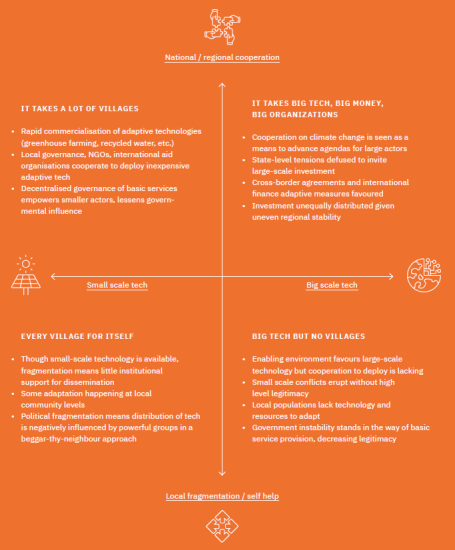Scenario-based analysis: Levant
Download the full report here.
The impacts of climate change are already adversely shaping security in the Levant region, comprising Israel, Jordan, Lebanon, Palestine and Syria.
In addition to projected climate change impacts and current conflict dynamics, future climate-linked security risks in the region are connected to social, cultural, economic, political, and technological factors that can drive conflict and insecurity, on the one hand, or stability and resilience on the other.
To better anticipate and respond to future risks, Weathering Risk worked with the International Military Council on Climate and Security Expert Group and the Center for Climate and Security, an institute of the Council on Strategic Risks, and regional experts using a scenario analysis method.
The experts identified the most important and most uncertain or difficult to predict drivers of climate security risks in the Levant. From those, two were selected: technological availability and international cooperation. The interaction between these drivers at their extremes produces four future scenarios for the region based on the expected physical climate change effects.

The process of developing and analysing these four scenarios highlighted the importance of state policy, governance, and cooperation as variables shaping states’ capacity to cope with climate change.
While the exercise did not identify significant new entry points for addressing regional governance or cooperation deficits, it did reveal that even in states with poor or absent governance and low levels of cooperation, societies may find ways of coping with adverse climate impacts if the means to adapt are readily available.
Our scenarios suggest that making small-scale adaptive technologies widely available may offer a path to increasing climate resilience in societies suffering from low cooperation and poor or even predatory governance.
Weathering Risk scenarios are not predictive nor exclusive – different drivers would produce a different set of futures. This Weathering Risk scenario exercise, rather, illustrates how wide-ranging possible futures could plausibly look like by showing how the interaction of just two drivers can produce very different outcomes, avoiding the trap of the single-line projection.
As policymakers and practitioners prepare today to manage the climate security risks of tomorrow, asking what would have to happen to bring about a scenario helps identify indicators to monitor and evaluate possible paths for action.
Share on


